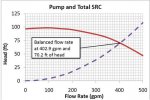Searched and found lots of low questions but not high. Is there such a thing as too high? This truck and MV's in general are new to me. At cold start it will read 120psi. Warm idle is 90 and loaded hot still just about 120. This truck had just received spin on filters and fresh oil before I got it. Is there a way to mess up the filter install and be running the engine bypassing the filters or such as I got no instructions with it. Any other thoughts?
thanks,mike
Hey TAKPAK!. Nice to see you on here. I’m in Portland so best we will cross paths one of these days.
I think there are different issues here that are getting confounded, so I’ll try to address them one at a time.
Can Oil Pressure be Too High? Yes! Abnormally high oil pressure can suggest that oil is not flowing properly, can blow lines and filters, wastes power by adding necessarily high load on the pump drive, etc. If your engine is truly developing abnormally high pressures, you should check out why it is happening.
What’s happing here is that you have a system composed of a pump and fluid flow path (the engine). The pump (and regulator) generates a pressure to move the fluid and thus the flow rate varies as a function of pressure. If you make a plot of this you usually get a curve for centrifugal pumps and a line of sorts for constant displacement pumps such as ours. The engine also has a curve that also shows the relationship between pressure and flow. Refer to the pic I found on the internet to illustrate the point. The intersection of these two curves will give the pressure and flow for the overall system. Of course, the pump and engine curves can change as a function of the fluid (type, viscosity, dilution, etc.), temperature, clearances, etc. As the engine wears I would expect the impedance curve to drift so that operating pressure reduces. Note that with pump systems pressure is often measured as “pressure head” as a distance so that it easily correlates to the height of the plumbing system in industrial applications. Hope this helps, wanted to lend an explanation without writing a thesis.

Another issue is the accuracy, precision, etc. of the sending unit and gage in the truck. If you have concerns about these sort of issues you should check your gage and sending unit as the other guys suggest (and you already have checked it with another gage, hopefully it is reading properly). As an example, if you take a known good (preferably calibrated) gage and put it on a T with your sending unit and a pressure source such as regulated LP air, you should be able to step through the range in say 5 psi increments and get the same reading on both gages. Otherwise you have an error. It looks like the mismatched gage and sending unit caused the issue that kicked this discussion off.
What I consider the best value of the gage in the cab is not the pressure itself in relation to a standard, but more having the ability to see if anything causes a change in pressure. Specifically something that may be wrong with the engine or knowing when to shut it down to investigate.
I run DELO 15-40W in my truck with jatonka spin-ons and it rarely moves much from 30psi. I haven’t taken time out to check it vs. another gage.



